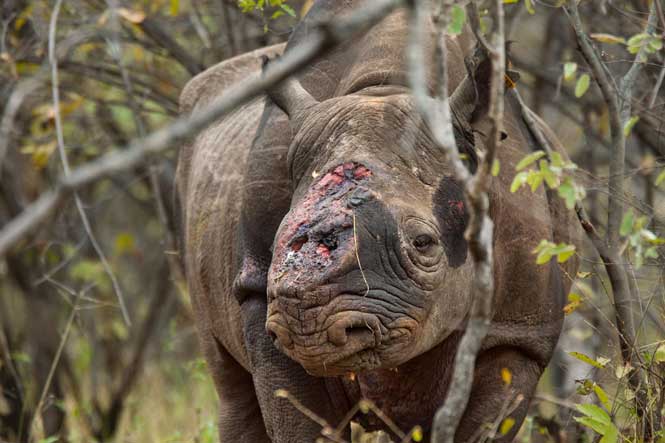
The Ivory trade has resulted in poachers seeking out and slaughtering animals such as Rhino and Elephants to such a degree that it is rapidly leading towards, not just the endangerment of species, but complete extinction.
The motivation that drives the now illegal poaching is well-understood, as explained by IFLS …
The belief that rhino horn treats fevers or beautifies the skin, has stoked a global industry with prices soaring to $65,000 per kilogram ($30,000 /pound).
With such a huge incentive, many poachers will happily accept the risk of being caught because the potential rewards are huge, and so the death toll of rhinos in South Africa alone has escalated from 13 rhinos in 2007 to a staggering 1,215 in 2014.
There have of course quite rightly been attempts to tackle this by putting in place restrictions and outright bans, but it is just not working. In that context there is now a San Francisco startup and come up with a new idea.
Pembient, a biotech company founded in January 2015 by Mathew Markus and George Bonaci, has a vision that involves bioengineering ivory that looks like the real thing and even has the same DNA signature, but is instead wholly synthetic. The idea is to flood the market with this fake ivory printed in volume on a 3D printer, and by doing so drive the price down to such an extent that poaching ceases to be economically viable. In theory it would in effect wipe out the economic incentive that the poachers currently have.
However, would this really work?
What do the various NGOs feels about this?
They are not convinced this will work and so have taken a stance against the synthetic product. On World Rhino Day 2015 (22 September), a coalition of 10 NGOs published a joint statement (Annamiticus website, 2015).
Wildlife Trade Experts Oppose Use of Synthetic Rhino Horn as Anti-Poaching Measure
“Introducing rhino horn from alternative ‘legal’ sources into an unpredictable market could stimulate further demand, provide a loophole into which poached rhino horn can be introduced into the market, and create huge challenges for enforcement authorities, putting the world’s remaining rhinos under even more pressure,” warns Adam Roberts, CEO, Born Free Foundation and Born Free USA.
In January 2016, within an article from Fauna and Flora International that appeared on their website, they outline a series of reasons why it believes synthetic / bio-fabricated horn will not save the rhino:
You can read their position on this here – In summary they also do not think the synthetic Ivory idea will work.
In February 2016, the Center for Biological Diversity and WildAid petitioned the Obama government to ban synthetic ivory.
In Spring 2016, the Zoological Society of London (ZSL) developed an internal position paper on synthetic / bio-fabricated wildlife products that also gives all this a big thumbs down …
“synthetic rhino horn meets none of the conditions that appear to be important for reducing demand,”
… and so this is their position …
“ZSL would be opposed to supplying synthetic rhino horn as a solution to illegal rhino poaching.”
Pembient Reactions
In response to various criticisms such as the above, they have modified their strategy. An initial plan to buddy up with a Chinese company to manufacture and sell beer containing powdered synthetic rhino horn is gone. A similar plan to market synthetic powdered rhino horn for luxury face creams in Vietnam has also been canned (that had gone as far as the launch of a video advertisement, in Vietnamese, on YouTube). So they now plan is to push ahead with bio-fabricated rhino horns that are used within the luxury carving market.
Botton Line: Given the quite strong opposition from all the various NGO organisations that are far closer to the reality of what is actually going on out there, and are deeply passionate about stopping the Ivory trade via an outright ban, I really don’t see Pembient being able to have a meaningful impact.
Links
- Dec 2015 National Geographic article all about this.
- New Harvest description of Pembient (If you are wondering what New Harvest is, then click here)
Quotes
“If you start to nuance that message with some rhino horn is good, some of it is bad, some of it is legal, some of it is illegal, you lose people and lose the clarity of the message.” – Patrick Bergin, CEO of the African Wildlife Foundation
“There’s very little, if any, relief on wild populations when we see commercial farming develop or commercial trade of a protected species, the wild trade continues right alongside.” – Douglas Hendrie, manager of the wildlife crime and investigations unit for conservation group Education for Nature – Vietnam.
Trying to protect elephants and rhinos with morality has not worked and now ivory is more valuable than diamonds. Through history we’ve seen markets collapse due to oversupply. Flood the Chinese market with synthetics and watch the price collapse.
An elephant is shot every fifteen minutes.
Please, please proceed with this.